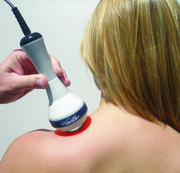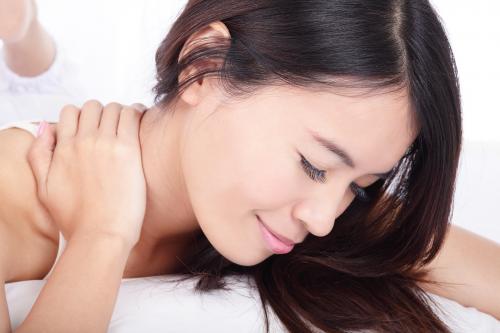Cold Laser Therapy - Portsmouth, NH

What is Cold Laser Therapy?
One of the treatments you will be receiving is called cold laser therapy or phototherapy; it may also be referred to as light therapy. Channelling therapeutic light energy for the purpose of reducing pain has been a widely accepted medical practice for many years. Your therapist may use phototherapy, which includes the delivery of superluminous diode (SLD) and low level laser therapy (LLLT), for temporary increase in local blood circulation, temporary relief of minor muscle and joint aches, pains, stiffness, and the relaxation of muscles, as well as for muscle spasms, and minor pain and stiffness associated with arthritis. It may also be used for the temporary relief of hand and wrist pain associated with carpal tunnel syndrome.
One of the treatments you will be receiving is called cold laser therapy or phototherapy; it may also be referred to as light therapy. Channelling therapeutic light energy for the purpose of reducing pain has been a widely accepted medical practice for many years. Your therapist may use phototherapy, which includes the delivery of superluminous diode (SLD) and low level laser therapy (LLLT), for temporary increase in local blood circulation, temporary relief of minor muscle and joint aches, pains, stiffness, and the relaxation of muscles, as well as for muscle spasms, and minor pain and stiffness associated with arthritis. It may also be used for the temporary relief of hand and wrist pain associated with carpal tunnel syndrome.
How does Cold Laser Therapy help?
Cold Laser Therapy or Phototherapy is a physical treatment modality using SLD and LLLT diodes to emit photons (light) in very specific regions of the electromagnetic spectrum which penetrate the skin stimulating a cascade of clinical benefits. Radiant energy absorbed by elements in mitochondria and cell membranes is converted into biological energy, inducing processes, such as increased local microcirculation, accelerated tissue repair, reduced pain, decreased inflammation and edema, enhanced immune response, and angiogenesis. Phototherapy can be used to treat both acute and chronic conditions, including whiplash injuries, osteoarthritis, migraine headaches, disc herniations, sprains/strains, bursitis, carpal tunnel, plantar fasciitis, and others listed in the table below. Research indicates that phototherapy can accelerate wound and tissue repair by as much as 30- 40%.
It is important to understand that phototherapy is not a cure-all. Occasionally, it may be the only therapy prescribed, but more often it is used in conjunction with other therapeutic and rehabilitative treatments. Your doctor or therapist will determine when phototherapy is indicated, how often it should be used, and the length of each application. The exact frequency of treatment depends upon the individual patient and the conditions being treated. Generally, periodic treatments are continued as long as the condition is present. Treatments may be given as often as 2-3 times per day in acute or serious conditions. In less serious cases, two to three times a week is common early in the treatment program with a gradual reduction in frequency as the patient improves. To receive maximum benefit from your phototherapy treatments, it is important to follow the recommendations and instructions of your doctor or therapist as precisely and completely as possible.
It is important to understand that phototherapy is not a cure-all. Occasionally, it may be the only therapy prescribed, but more often it is used in conjunction with other therapeutic and rehabilitative treatments. Your doctor or therapist will determine when phototherapy is indicated, how often it should be used, and the length of each application. The exact frequency of treatment depends upon the individual patient and the conditions being treated. Generally, periodic treatments are continued as long as the condition is present. Treatments may be given as often as 2-3 times per day in acute or serious conditions. In less serious cases, two to three times a week is common early in the treatment program with a gradual reduction in frequency as the patient improves. To receive maximum benefit from your phototherapy treatments, it is important to follow the recommendations and instructions of your doctor or therapist as precisely and completely as possible.
Conditions Commonly Treated with Cold Laser Therapy
|
|
|
|
Get Cold Laser Therapy Today!Chances are if you have a sports injury, you would benefit from Cold Laser Therapy . If you feel sore or your muscles are not working right don’t hesitate to book an appointment today or call (603) 431-4200 to see if Cold Laser Therapy is right for you.
Please take a moment and see if any of the other services we provide at Seacoast Sports injuries could help you achieve you Health and Athletic Goals. |

